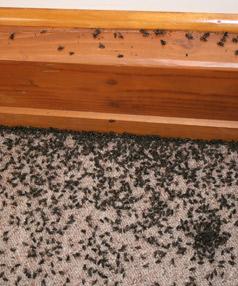If staff in top-floor offices are complaining about flies – or your loft space is overrun with insects – it’s probably cluster flies.
Cluster flies or Pollenia rudis are ‘field’ flies – they lay eggs in the soil and the larvae burrow into earthworms where they pupate. As the weather becomes cooler, they seek out shelter in nooks and crannies in buildings to hibernate in large numbers. Their favourite places are roof spaces and lofts and people living in houses in the country are often plagued with swarms of cluster flies in their lofts. Normally, several thousand flies will cluster together – hence the name cluster flies. They will usually infest the highest warm point available – and this is often the top floor of offices or loft spaces in people’s homes.
Cleankill Environmental Services Managing Director Paul Bates explains: “As cluster flies don’t breed indoors, controlling them outside is impractical. It’s often impossible to keep flies from entering premises, no matter how well sealed or modern the property is. The flies enter through air vents, breathing points in mortar, roof tiles and even through gaps in modern double glazing.”
Insecticidal spraying around window and door frames and other entry points can help. Once flies are inside, control can be achieved with a range of insecticides and electronic ultra-violet fly machines. While there is a specific species of common cluster fly, there are other species of swarming flies which have a similar hibernating nature. The life cycle of the cluster fly is very much dependent on the prevailing weather conditions and, in this country, two generations a year are usual but, in hot summers, up to four generations per year are possible.
Curiously, a single house or one building in a row of similar buildings is often chosen year after year for this clustering phenomenon. Large numbers of cluster flies hibernating together are capable of producing a sickly smell and, if their local environment becomes warmer for any reason, they will emerge to fly around, albeit rather lazily. They are attracted to light and some will find their way into other areas of the house to the horror of people living there. However, while cluster flies can be a source of nuisance on occasion, it is not considered that they pose a risk to human health and their presence should not be taken as evidence of poor hygiene. The typical cluster fly is about 7 mm long and has distinct lines or stripes behind the head, short golden-coloured hairs on the thorax and irregular light and dark grey areas on the abdomen. Cluster flies are typically slow-moving. Eight species are found in Britain and 31 in Europe.
Cleankill has been solving pest problems for commercial and domestic customers for more than 15 years. Using the most up-to-date pest-control techniques and technology, the company keeps its customers pest free and makes sure it is at the forefront of the industry when it comes to the use of pesticides and non-toxic pest control methodology. As an Investor in People, all Cleankill’s staff are highly trained and offer an exceptionally fast and efficient level of service. The company is a proud member of the British Pest Control Association, as well as being approved to ISO9001 and ISO14001. Cleankill is also fully accredited to the Safecontractor, Exor, Constructionline and Achilles Health and Safety Accreditation Scheme and aims to be recognised as a market leader for innovation and new pest control techniques.
ENDS
For further information or interview requests, contact Suzi Christie at Blueberry PR on 01435 830031 or e-mail suzi@blueberry-pr.co.uk
